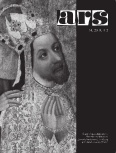
Journal ARS 51 (2018) 1-2
Jiří KUTHAN
The Kingdom of Bohemia and England During the Luxembourg Era
(Summary)
Despite the considerable distance between Central Europe and England it is possible to record numerous relations between Kingdoms of Bohemia and England in the 13th century. During the reign of Ottokar I of Bohemia, the marriage of his daughter Agnes to the English king Henry III was discussed in the years 1226 – 1227. A Cistercian monk Robert, who came from England, became the Bishop of Olomouc. Richard of Cornwall, brother of King Henry III, crowned the King of the Romans in Aachen on 17th May 1257, granted the fiefs of Austria and Styria Ottokar II of Bohemia. Richard of Cornwall’s seal served as an inspiration for Ottokar II’s third seal. The Bohemian King Wenceslaus II turned to England in order to request the relic of St. Thomas Becket. Relations between the Bohemian Kingdom and Western Europe intensified during the reign of John of Luxemburg. He and his military contingent supported the French king Philip VI whose army was defeated by the English in the battle of Crécy where King John and some of his convoys lost their lives. John’s son and his successor, the future Emperor Charles, came in contact with England long before the forementioned encounter – when he participated as a young man in the ceremony of swearing the Oath of Fealty of the King of England to the King of France that took place at the French royal court. In the final years of Charles’ life, the negotiations regarding the matter of marriage of his daughter Anne (1366 – 1394) to English King Richard II (1367 – 1400, crowned 1377) started. The wedding was realized after Charles’ death in January 1382 at Westminster Abbey. It was also here that a tombstone was erected during Richard II’s life with figures of Richard and his first wife, Anne of Bohemia. Royal representations by the means of architecture and art as developed in England in the era of Richard II and Anne of Bohemia were in the last third of the 14th century the most remarkable phenomenon of its kind. It is possible to identify an echo of Prague art in English millieu – for example in the illumination of the Codex Liber Regalis (Westminster Abbey, London MS 38). When the Earl of Derby, the future King of England Henry IV, visited Wenceslaus IV, the Holy Roman Emperor and King of Bohemia, in Prague and at Žebrák Castle during the life of Anne of Bohemia, he bought in Prague a couple of paintings, had them decorated with precious stones and then had them blessed, too. Relations between England and Bohemia were also reflected in a lively reception of John Wycliffe, an English theologian and thinker, whose texts were brought to Bohemia in a form of copies. Wycliffe´s criticisim of the Church met with positive reactions at Prague University and was no doubt accepted also by the Prague court of Wenceslaus IV, especially after the escalation of the conflict between the souvereign and John of Jenstein, the Archbishop of Prague. John Wycliffe´s ideas became a source of inspiration for Jan Hus, which consequently led to the Hussite revolution. Similarities in English architecture and the work of Prague-based Peter Parler led to speculations about the possibility of Parler’s inspiration by English Gothic – and if so, whether this inspiration was mediated by drawings or whether Parler saw some of the English Gothic buildings himself before him coming to Prague. The distance between Prague and London is not short, yet it is possible to identify numerous connections between architecture and other arts in the Kingdom of Bohemia and England throughout the 13th and especially 14th century.